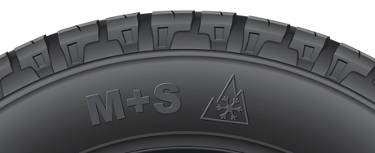You know that winter tires are specially designed to perform better than other tire types in winter weather. But maybe you’ve seen these symbols on the side of your tire: M+S and a three peak mountain with a snowflake?
These symbols are found on tires that offer inclement weather performance but many customers, even seasoned tire buyers, don’t understand what they really mean or how they’re different.
WHAT DOES M+S MEAN ON A TIRE
M+S stands for “Mud and Snow” and designates that a tire offers better traction in mud and snow conditions compared to a standard tire. However, to achieve this requirement a tire needs only have 25% of its tread pattern be open space. There is no requirement for testing in mud or snow conditions.
M+S tires should not replace a dedicated snow tire in regions that experience true winter conditions.
Tire manufacturers began adding the M+S (or M&S, M/S, or MS) symbol to tires starting in the 1970s. The original idea behind this designation was to note that the tire would be of a “knobby” variety, such as a mud or an all-terrain tire that would be expected to handle difficult driving conditions.You can still find it on all-terrain tires today.
However, the M+S doesn’t mean you can rely on a tire with this badging as a true winter tire. Tires bearing only the M+S marking have not been tested in mud or snow conditions. Manufacturers often use this badging to help customers identify what kind of tire it is.
The M+S symbol is a manufacturer originated addition. There is no industry standardization of the tire’s performance capabilities and can be found on many tire types, including all-season and all-weather tires.
THREE PEAK MOUNTAIN SNOWFLAKE TIRES
Three-peak mountain snowflake tires have been tested and proven capable of performing under extreme winter weather driving conditions. It features a three-peaked mountain with a six-sided snowflake in the middle.
Tire manufacturers realized that drivers needed an indicator of a tire’s capability in winter. In the 1990s, the U.S. Tire Manufacturers Association (USTMA) created this standard.
The standard outlines the acceptable minimum of traction in medium packed snow compared to a standard tire. Tires that meet or exceed performance requirements of the USTMA can be labeled with the three-peak mountain snowflake designation, also called the “Alpine” or severe weather symbol.
All true winter tires include the three-peak mountain snowflake (sometimes abbreviated as 3PMS) symbol.
Limitations
The standard for three-peak mountain snowflake tires defines minimums for traction in severe snow conditions. It does not, however, take into account braking or turning in snow or icy conditions.
Therefore, there’s no guarantee that the three-peak mountain snowflake tire you’re considering will be the best choice for your region’s winter conditions. In some cases, you may need to add tire studs or tire chains where legally permitted.
Ready to roll?
If you have any questions or are unsure what tires work best for you, drop in or give us a ring. We’ll get you taken care of. Buy and book online and save time in-store!
For more information on this and other tire and wheel services, check out our YouTube Channel or reach out to us on X, Facebook and Instagram.
